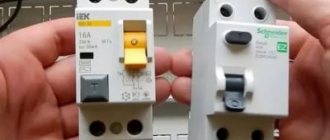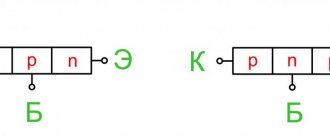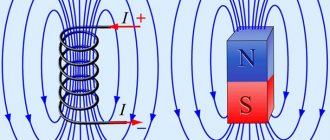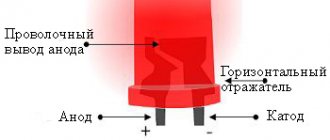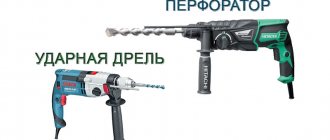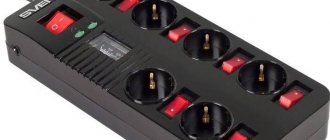All electrical networks are protected by insulating shells. Sometimes situations arise when the insulation is broken and a current leak occurs, which can cause serious damage to human health and life. In order to prevent such a danger, RCDs are used, the decoding of the name of which means a residual current device. RCDs are capable of instantly turning off electric current, thereby providing reliable protection, especially in the absence of grounding.
What is the difference between an RCD and a difavtomat in simple words: 7 differences for ordinary people
The electrical safety of your own home worries any apartment owner, and the technical terminology of protective modules is so confusing that an uninitiated person can easily make a mistake when choosing them.
For example, the names “Differential switch” and “Automatic differential switch” sound approximately the same, but they contain a huge difference.
In the article, I explain in detail how an RCD differs from a difavtomat in simple words for a novice home craftsman.
- How to distinguish an RCD, a difavtomat and a circuit breaker by purpose: the most important principle How a residual current device works: a brief explanation
- Circuit breaker: module protective functions
- What protection does the difavtomat provide in home wiring?
- Difference in rated current markings on the front side
- What elements are shown on the body diagram?
- Inscriptions and designations of modules
How to choose
A good electrician will recommend an RCD manufacturer and calculate the load, but you need to be sure that the recommendations are correct
And if you purchase everything yourself for repairs, then all the more you need to understand what to look for when choosing a device
Price
Do not purchase a device in the lower price range. The logic is simple: the higher quality the components inside, the higher the price. For example, some cheap devices do not have burnout protection, and this can lead to fire.
A cheap device can be made of fragile materials and can easily break when you lift up the lever that is lowered when triggered. According to the standard, the RCD must be designed for 4,000 operations. This means that you will only have to make a choice once, but only if you have purchased a quality product. By purchasing a low-quality device, you put yourself and your loved ones at risk, not to mention material losses in the event of a fire.
Case quality
Pay attention to how tightly all parts of the device fit together. The front panel should be monolithic and not consist of two halves
The preferred material is heat-resistant plastic.
Device weight
Give preference to heavier devices. If the RCD is light, it means that the manufacturer has saved on the quality of internal components.
CHARACTERISTICS AND MARKING OF DIFFERENTIAL AUTOMATICS
In international practice, it is customary to mark the breaking capacity with letters of the Latin alphabet.
A - used in networks with long conductors and have a breaking capacity of 2-4 In.
B – are used, as a rule, in networks that exclude inductive loads; These are mainly networks used for lighting; breaking capacity – 3-6 In.
C - differential circuit breakers with this marking can be used in networks with a combined load, that is, they can withstand short-term current overload that occurs during the start-up of electric motors; breaking capacity – 5-10 In.
D - switches of this group are also used in networks with combined loads, but unlike the previous group they have a higher current setting - 10-20 In.
K – highly specialized devices used in networks in which the inductive load accounts for more than 80% of the total network load; the breaking capacity of this group is 8-15 In.
Z – this group of machines is used in low-current networks or power supply circuits of electronic equipment that do not allow even short-term current overloads; breaking capacity – 1-3 In.
As for protection against leakage currents, here it is necessary to determine the category of the room in the network in which the differential is installed. machine.
Currently, devices are produced with different settings (IΔn) for protection against leakage currents, namely:
- 10.30 mA – used to protect people from electric shock;
- 100, 300, 500 mA - used to prevent fires as a result of insulation damage or short circuit of live parts to ground.
Also on the body of the differential circuit breaker there is a letter marking that determines the possibility of shutdown for different types of leakage currents:
AC – variable nature of leakage currents. Automatic machines with this marking are used in networks with a significant inductive load, lighting networks, and power supply circuits for electric motors.
A is the most common type recommended for use in power circuits of household appliances. The operating characteristic of leakage currents is alternating pulsating.
B - this category of differential automatic machines is used exclusively in industrial installations. The nature of the leakage current is constant, smoothed and variable.
S – used to provide multi-level, selective protection. The required selectivity is achieved by delaying the operation of the device; The shutdown delay is 0.1-0.5 s.
G - also used to ensure selectivity, but with a shorter response delay - 0.05-0.09 s.
Based on voltage, differential circuit breakers are divided into single and three-phase; accordingly, for a three-phase network, three-phase devices should be installed. In the absence of a single-phase automatic circuit breaker, as a temporary measure, it is possible to install a three-phase circuit breaker in a single-phase network, although with a decrease in the efficiency of current protection.
Connection procedure
Connecting an RCD with and without grounding
The procedure for connecting an RCD to an electrical circuit is regulated by current standards (PUE, in particular). In accordance with regulatory requirements, the location where the device is switched on is determined taking into account the possibility of general or selective switching of supply lines. If there is only one RCD used for the entire apartment, it is installed on the DIN rail of the electrical panel immediately after the electric meter and in front of the linear circuit breakers that protect individual loads.
When using the device as a selective element, it is mounted in a branch from the common power line, which requires special protection.
The zero of a single-phase network is connected to the upper terminal marked “N”, and is removed from the lower contact, which has a similar marking. For the case of installing a 4-pole device in a three-phase power line, the number of phase contacts will triple (the N terminals to which the ground should be connected will remain unchanged).
Differential machine (Part 1). Types and work. Device
Let's consider one type of protection - a residual current circuit breaker, or a differential circuit breaker. This device includes the functions of a residual current device and a circuit breaker. It provides protection of the controlled circuit from short circuit currents and overload currents, working as a circuit breaker. Also, the differential circuit breaker protects a person from possible electric shock as a result of leakage currents, prevents fire due to damage to the insulation of current-carrying elements of an electrical installation, while performing the functions of an RCD.
Kinds
The division of automatic machines into types is carried out according to their characteristics. Let's look at the main types of such devices.
Electrical network type
All protection devices are selected according to the number of phases of the electrical network. There are differential circuit breakers for operation in a single-phase network of 220 volts, and for a three-phase network of 380 volts. There is a corresponding designation on the device body. Three-phase models are equipped with a zero pole and three phase poles. Its dimensions are much larger, in contrast to the single-phase model, which has a phase and zero pole. In the first picture on the left is a single-phase machine, on the right is a three-phase one.
Current parameters
The current rating is indicated by the letter “C” next to the load current number in amperes.
C16 automatic machines have become popular in everyday life. Other types are used less frequently. The leakage current is indicated by the symbol Δ, and to the right of this symbol the current in milliamps is indicated. In lighting circuits, difautomatic devices with a rated leakage current of 10-30 mA are most often used. Of these, 10 mA circuit breakers are used for single networks, and 30 mA circuit breakers for group networks. Protection with a rated leakage current of 100-300 mA is used for input circuit breakers.
Criteria for selecting electrical protection devices
Let's try to figure out what is better for the home - an RCD or a differential circuit breaker, and consider various installation situations. Most often, the choice is influenced by factors such as the position of the device in the electrical panel, the nuances of connecting to power lines, and the possibility of maintenance or replacement.
Features of installation in an electrical panel
An electrical panel is a metal box, inside of which protection devices and an electric meter are usually located. The working panel to which the devices are attached is limited in size.
If the electrical network is improved and additional modules are installed, then there is a shortage of free spaces on the DIN rails. In this case, difautomats find themselves in an advantageous position.
Layout of “automatic + RCD” pairs on the DIN rail (top row) and automatic circuit breakers (bottom row). Obviously, lower units take up less space. The difference will increase if the protection is designed for a larger number of circuits
Modern equipment of apartments with electricity is focused on increasing the number of circuits. This is due to the emergence of a large number of powerful equipment, and to the division of the network into many lines. In such a situation, in the absence of additional space, the only reasonable solution is to connect difavtomats.
When selecting devices, pay attention to devices that occupy one module-space. Such models have already appeared on sale, but their cost is slightly higher than traditional ones.
Difficulty connecting wires
The main difference in connection between the two indicated options is the number of wires. Two separate devices have more terminals in total - 6 pieces, while the difavtomat has only four. The connection diagram is also different.
Comparative diagram of installation and connection of a protective pair and a difautomatic device. The result of operation in an emergency situation and the reliability of the devices are the same, but the order of connecting the wires is different
The diagram clearly shows the wiring connections.
When connecting a pair of AB + RCD, the situation is as follows:
- the phase wire is connected to terminal AB;
- the output of the machine and the L-terminal of the RCD are connected by a jumper;
- the output of the RCD phase is sent to electrical installations;
- the neutral wire is connected only to the RCD - at the input with the N-terminal, at the output - it is sent to electrical installations.
With a difavtomat, the connection is much simpler. Jumpers are not needed, just connect phase and neutral to the corresponding terminals, and send them from the outputs to the load.
What does this give to the installer? Facilitates the connection process, reduces the number of wires, and, accordingly, guarantees more order in the electrical panel.
How is triggering diagnosed?
If we consider devices from the middle price segment, then the tandem “automatic device + RCD” has advantages. Suppose there was an emergency power outage on one of the circuits.
It is difficult to immediately determine the reason for the protection to operate, since it could be a leakage current, a short circuit, or a total load that the wires could not cope with.
When an RCD or circuit breaker is triggered, you can immediately see where to look for the cause. In the first case, there is an insulation problem, in the second, there is an increased load or a short circuit. The latter can be determined by additional characteristics
If the automatic machine responded to a network failure, then it will take longer to look for the cause. It is necessary to check all versions, and this will take more time and effort.
To simplify diagnostics, it is recommended to purchase devices from a more expensive price segment - they are equipped with additional indications indicating a possible problem.
Which devices are cheaper to buy and repair?
There are situations where the choice is based on cost. For example, there is a budget that cannot be exceeded. In this case, the total cost of all connected protection devices plays a decisive role.
At first glance, a larger number of devices are characterized by a higher price. In fact, everything is different: a universal automatic machine costs a tidy sum, but a set of other devices turns out to be economical.
If you monitor the price tags of all the designated machines, it turns out that one automatic machine is almost twice as expensive as the “AV + RCD” set
It should be remembered that the number of lines is usually 3 or more, so the difference between purchases increases. If for one circuit the purchase of RCBOs is only 1 thousand rubles more expensive, then for five circuits the difference in amounts grows to 5 thousand rubles.
Thus, both automatic devices and RCD units with circuit breakers have their advantages and disadvantages. If RCBOs win in compactness and ease of connection, then they clearly lose in diagnostics and cost accounting.
A large assortment.
Since each manufacturer has its own layout of various components (on lever, test button, signal beacon, symbols and schematic drawing), and these modules are very similar in appearance, it is not possible to remember the visual features of any one type of device.
But some electricians claim that in RCDs the disconnect lever is located closer to the right edge, while in automatic machines it is on the left side. Some manufacturers actually designate the type of protective device in this way, but this statement is not true for all switches.
Abbreviation on the body
Since manufacturers know that ordinary people are often confused about these devices, many of them put the corresponding abbreviations on the side of the case. The residual current device corresponds to the letters VD (differential current switch), the technical abbreviation of the difavtomat is AVDT (which means automatic differential current switch).
This sign allows you to accurately understand what a specific device is - an RCD or a differential circuit breaker. Unfortunately, such designations are found only on devices from Russian manufacturers; imported devices do not have this marking.
Main reasons for triggering
When the devices are triggered, it is necessary to find out the reason for the shutdown. There can be many of them, but there are 4 main ones:
- Leakage current.
- Line overload.
- Short circuit in the cable.
- Malfunction of protection devices.
If both devices are used together, then the reason for the shutdown is easy to find: if there is a current leak, the RCD is triggered; if there is a short circuit or line overload, the circuit breaker is triggered.
If after pressing the “Test” button on the automatic machine the problem remains, then the device is faulty and must be replaced.
Electromechanical or electronic – which is better?
By analogy with RCDs, difavtomats are manufactured either with an electromechanical residual current device or with an electronic one.
The electromechanical device does not require additional power supply to operate. The energy to activate the trip coil, which removes the automatic device from the on state, is taken from the source of the leakage current. Therefore, the differential transformer that registers these currents in electromechanical devices has large dimensions. Its task is not only to sense the leak, but also to convert its small value into a voltage sufficient to trigger the device.
The large dimensions of the transformer increase the size of the device as a whole. Therefore, the volume they occupy in the panel is greater than that of electronic ones .
Electronic automatic devices, in addition to a leakage current sensor and a tripping coil, contain an electronic circuit with a signal amplifier. A small signal from the sensor increases to an amplitude and power sufficient to operate the release coil.
These automatic machines are more compact, but does that mean they are better? In fact, their advantages are limited to compactness. There are situations in which this device will not help.
Letter designation of RCD on electrical diagrams
Any element on electrical circuits is assigned not only a graphic designation, but also an alphabetic designation indicating a position number. This standard is regulated by GOST 2.710-81 “Alphanumeric designations in electrical circuits” and is mandatory for application to all elements in electrical circuits.
So, for example, according to GOST 2.710-81, it is customary to designate circuit breakers using a special alphanumeric designation in this way: QF1, QF2, QF3, etc. Switches (disconnectors) are designated as QS1, QS2, QS3, etc. Fuses in the diagrams are designated as FU with the corresponding serial number.
Similarly, as with graphic symbols, GOST 2.710-81 does not contain specific data on how to carry out the alphanumeric designation of RCDs and differential circuit breakers on diagrams .
What to do in this case? In this case, many masters use two notation options.
The first option is to use the most convenient alphanumeric designation Q1 (for RCD) and QF1 (for RCBO), which indicate the functions of the switches and indicate the serial number of the device located in the circuit.
That is, the encoding of the letter Q means “switch or switch in power circuits,” which may well be applicable to the designation of an RCD.
The code combination QF stands for Q – “switch or switch in power circuits”, F – “protective”, which may well be applicable not only to conventional machines, but also to differential machines.
The second option is to use the alphanumeric combination Q1D for the RCD and the combination QF1D for the differential circuit breaker. According to Appendix 2 of Table 1 of GOST 2.710, the functional meaning of the letter D means “differentiating”.
I very often saw in real diagrams the following designation: QD1 - for residual current devices, QFD1 - for differential circuit breakers.
What conclusions can be drawn from the above?
| Due to the fact that there is no designation for RCDs and differential circuit breakers according to GOST, the information discussed in this article does not apply to mandatory regulatory documents, but is only a RECOMMENDATION. Each designer can depict these elements on the diagrams at his own discretion. To do this, you just need to provide conventional graphic designations (UGO) of the elements, their decoding and explanations for the diagram. All these actions are provided for in GOST 2.702-2011. |
